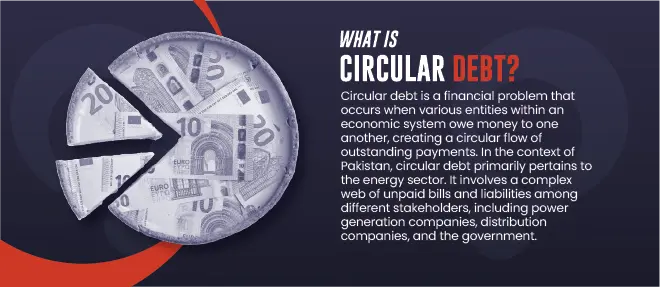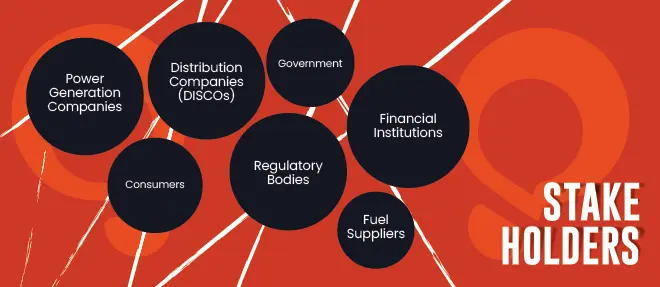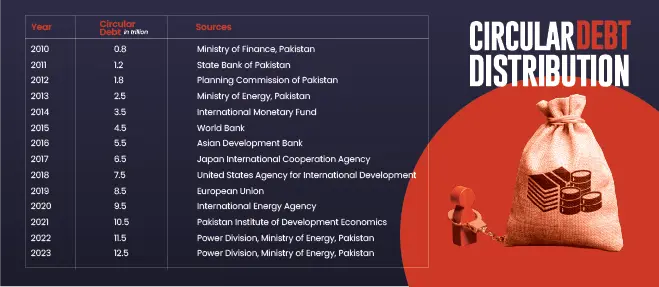In recent years, the term “circular debt” has become a recurring concern in Pakistan’s economic landscape. This complex issue has far-reaching implications for the country’s energy sector, affecting both the government and the general public. In this article, we will delve into what circular debt is, its current state in Pakistan as of 2024, and potential solutions to address this mounting challenge.
Circular Debt in Pakistan
1. Understanding Circular Debt in Pakistan
2. What is Circular Debt?

Circular debt is a financial problem that occurs when various entities within an economic system owe money to one another, creating a circular flow of outstanding payments. In the context of Pakistan, circular debt primarily pertains to the energy sector. It involves a complex web of unpaid bills and liabilities among different stakeholders, including power generation companies, distribution companies, and the government.
The government owes money to Independent Power Producers (IPPs) for the electricity they generate, but the government’s power distribution companies (DISCOs) do not collect enough money from consumers to pay the IPPs. This creates a vicious cycle, as the IPPs are unable to pay their own suppliers, and the DISCOs are unable to invest in improving their infrastructure.
Here is an example for you to better understand:
Imagine you have a group of friends who like to borrow things from each other. One day, friend A borrows a pen from friend B, and friend B borrows a book from friend C. Now, friend C needs to borrow something from someone too, maybe a puzzle from friend A.
Now, imagine this keeps going around in a circle. Friend A owes something to friend B, who owes something to friend C, and friend C owes something to friend A. It’s like a never-ending cycle of borrowing and owing.
In Pakistan, something similar happens with money in the electricity and energy sector. Power companies owe money to each other, and they also owe money to the government. The government, in turn, owes money to the power companies. This cycle of money going around and around is what we call circular debt.
The circular debt issue in Pakistan involves several key players within the energy sector and the government. The main players include:

- Power Generation Companies: These companies are responsible for producing electricity in Pakistan. They include both public and private sector entities. Power generation companies often face delayed payments from distribution companies, affecting their financial stability.
- Distribution Companies (DISCOs): Distribution companies are responsible for transmitting electricity to consumers. In Pakistan, DISCOs often struggle with technical losses, electricity theft, and inefficiencies, leading to difficulties in recovering their operational costs and paying power generation companies.
- Fuel Suppliers: To generate electricity, power generation companies require fuel sources such as natural gas, oil, and coal. Fuel suppliers play a crucial role in the circular debt chain, as they often face delayed payments from power generation companies.
- Government: The government is a significant player in the circular debt issue. It provides subsidies on electricity tariffs to keep them artificially low, which contributes to revenue shortfalls in the energy sector. The government also manages the financial flow within the circular debt and is responsible for addressing and resolving the issue.
- Regulatory Bodies: Regulatory bodies like the National Electric Power Regulatory Authority (NEPRA) oversee the energy sector in Pakistan. They play a role in setting tariffs and ensuring compliance with regulations. Their effectiveness in addressing issues within the sector, such as tariff determination and improving efficiency, can impact the circular debt problem.
- Consumers: While not directly involved in the financial aspects of circular debt, consumers in Pakistan bear the consequences of this issue. Electricity shortages and power outages can affect households, businesses, and industries, impacting their daily lives and economic activities.
- Financial Institutions: Banks and financial institutions that lend money to power generation companies and other stakeholders within the energy sector also play a role in the circular debt issue. Delays in payments can lead to financial stress within these institutions.
3. Circular Debt in Pakistan in 2024
As of 2024, circular debt remains a significant challenge for Pakistan. The circular debt’s quantum has continued to rise, reaching alarming levels. Despite government efforts to mitigate the issue, it persists, affecting the energy supply chain and economic stability.
The Pakistani government has taken a number of steps to address the circular debt problem, but these measures have had limited success so far. In 2023, the government approved a new Circular Debt Management Plan (CDMP), which aims to reduce the circular debt stock by 22% by the end of FY24. However, the government has struggled to implement the CDMP effectively.
In February 2023, the International Monetary Fund (IMF) approved a $6 billion loan to Pakistan, on the condition that the government take steps to address the circular debt problem. The IMF has urged the government to raise electricity tariffs, improve collection rates, and reduce subsidies.
The Pakistani government has also announced a number of other measures to address the circular debt problem, such as privatizing some of its DISCOs and selling off some of its power generation assets. However, it remains to be seen whether these measures will be successful in reducing the circular debt to a sustainable level.
Overall, the state of circular debt in Pakistan in 2023 is concerning. The circular debt stock has reached a record high, and the government has struggled to implement effective measures to address the problem. The outlook for 2024 is also uncertain, as the government will need to implement the IMF’s recommendations and other measures in order to reduce the circular debt stock to a sustainable level.
Some Important Statistics

- As of 2022, the circular debt in Pakistan had reached around PKR 2.5 trillion (Source: Power Division, Government of Pakistan).
- The average tariff differential subsidy (TDS) provided by the government in 2021-2022 was approximately 1.8% of the Gross Domestic Product (GDP) (Source: Economic Survey of Pakistan 2021-2022).
- Technical losses in the transmission and distribution system in 2023 were approximately 19% (Source: NEPRA State of the Industry Report 2023).
- Estimated annual losses due to power outages and energy shortages in Pakistan were up to 4% of the GDP (Source: World Bank’s Pakistan Development Update 2021).
4. Key Reasons of Circular Debt in Pakistan
- Underpricing of Electricity: Pakistan’s electricity tariffs are often set below the cost of production. As of 2022, the average tariff differential subsidy (TDS) provided by the government was around 1.8% of the Gross Domestic Product (GDP), contributing to circular debt (Source: Economic Survey of Pakistan 2021-2022. This is usually always driven by political factors above anything else.
- Inefficient Distribution Companies: Distribution losses in Pakistan’s power sector have consistently been a concern. As of 2023, the technical losses in the transmission and distribution system stand at around 19% (Source: NEPRA State of the Industry Report 2023.
- Unpaid Subsidies: The government has been consistently providing subsidies on electricity to protect consumers from rising energy costs. The fiscal year 2021-2022 saw subsidies amounting to approximately PKR 474 billion (Source: Economic Survey of Pakistan 2021-2022).
- Delayed Payments: As of 2022, the circular debt in Pakistan’s energy sector reached approximately PKR 2.5 trillion (Source: Power Division, Government of Pakistan). This chain of delayed payments affects everyone involved, from power generation companies to fuel suppliers and distribution companies.
5. How did Circular Debt start?
The problem of circular debt in Pakistan began to surface in the mid-2000s and has since persisted and grown. Several factors contributed to the initiation and exacerbation of this issue:
- Underpricing of Electricity: The underpricing of electricity, where the government set electricity tariffs below the actual cost of production, initiated the circular debt problem. The government aimed to keep electricity affordable for consumers, but this led to a revenue shortfall for power generation companies.
- Unpaid Subsidies: The government started providing subsidies on electricity to protect consumers from rising energy costs. While subsidies are essential to ensure affordability, they increased the government’s financial burden, as it had to cover the difference between the lower tariffs and the actual production costs.
- Increasing Energy Demand: As Pakistan’s population grew and industrialization expanded, the demand for electricity increased. This placed additional pressure on the energy sector, leading to greater borrowing and delays in payments.
Circular debt gives us insight into the detrimental effect of politicians making decision according to the election cycle and not according to what is required or warranted.
6. Consequences of Circular Debt
- Energy Shortages: Circular debt leads to power outages and energy shortages, affecting industries, businesses, and households. These shortages have resulted in estimated annual losses of up to 4% of the GDP (Source: World Bank’s Pakistan Development Update 2021).
- Financial Stress: Circular debt places financial stress on power generation companies, fuel suppliers, and distribution companies, impacting their ability to invest in infrastructure and operations.
- Government Burden: Subsidizing electricity diverts significant resources from other critical sectors.
- Investor Confidence: It reflects a lack of fiscal discipline and transparency, deterring foreign and domestic investment.
7. Solutions to Address Circular Debt
- Tariff Rationalization: Implementing a transparent and cost-reflective tariff structure is essential. The tariff differential subsidy must be gradually reduced to avoid revenue shortfalls.
- Improving Efficiency: Investments to improve the efficiency and capacity of distribution companies are crucial. Technical losses need to be reduced to a sustainable level.
- Policy Reforms: Transparency and accountability must be enhanced within the energy sector. Regulatory bodies like NEPRA should be strengthened to prevent mismanagement and corruption.
- Debt Retirement Plans: Implementing debt retirement plans through mechanisms like energy bonds can help reduce the burden of circular debt.
- Investment in Alternative Energy Sources: Promoting investment in renewable energy sources can diversify the energy mix, reduce dependence on fossil fuels, and contribute to a more sustainable energy sector.
Read More: Growing circular debt
8. What measures has the state taken against Circular Debt?
The circular debt issue in Pakistan has been a persistent challenge, and the government has implemented several policies and measures to address it over the years. While these policies aim to resolve the issue, results and statistics often reflect ongoing challenges. Here are some key policies and their timelines, along with relevant results and statistics:

Policy 1: Energy Sector Reforms (2010-2013)
Timeline:
- This policy was initiated in 2010 and extended through 2013.
Key Measures:
- Tariff adjustments to reduce revenue shortfalls.
- Rationalization of subsidies to reduce the fiscal burden.
- Improvement of energy sector governance and transparency.
Results and Statistics:
- During this period, circular debt levels reduced from their peak in 2013 but remained a significant concern.
- The government aimed to reduce the gap between electricity production costs and tariffs, resulting in some improvement in the circular debt situation.
Policy 2: Debt Retirement Plan (2018)
Timeline:
- Announced in 2018.
Key Measures:
- Introduction of a Debt Retirement Plan to address circular debt through the issuance of energy bonds.
Results and Statistics:
- While the plan aimed to retire a portion of the circular debt, the issue persisted, and circular debt continued to grow.
- The success of this measure in reducing the debt was limited, as the underlying structural issues remained.
Policy 3: Power Sector Revival Plan (2020)
Timeline:
- Introduced in 2020.
Key Measures:
- Measures to improve the financial sustainability of the energy sector, reduce inefficiencies, and recover outstanding dues from defaulters.
Results and Statistics:
- While the plan aimed to address the issue, circular debt levels continued to rise, and the energy sector remained financially stressed.
Policy 4: Comprehensive Circular Debt Management Plan (Ongoing)
Timeline:
- Ongoing as of 2023.
Key Measures:
- A comprehensive circular debt management plan with a focus on recovering outstanding dues, reducing inefficiencies, and improving transparency.
Results and Statistics:
- As of 2022, circular debt in Pakistan had reached approximately PKR 2.5 trillion, indicating the challenges in reducing the issue (Source: Power Division, Government of Pakistan).
- Despite ongoing efforts, circular debt continues to be a significant concern, impacting energy supply and economic stability.
The circular debt problem remains a persistent challenge, and despite various policies and measures, it has continued to grow. The complex nature of the issue, including underpricing of electricity, inefficiencies in the energy sector, and fiscal pressures, makes it a complex problem to resolve. Ongoing efforts are essential, and addressing the circular debt issue will require a multi-faceted approach and sustained reforms within the energy sector in Pakistan

